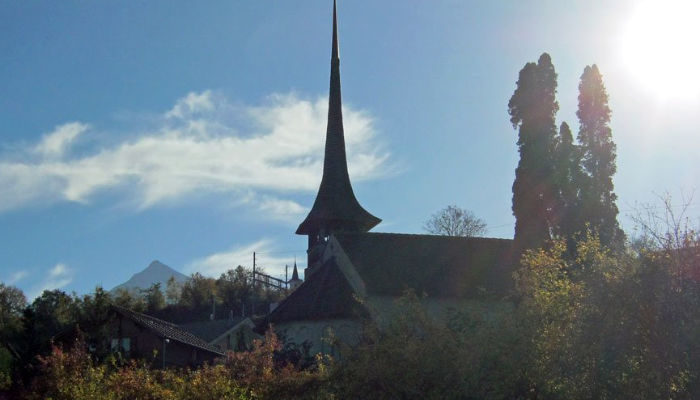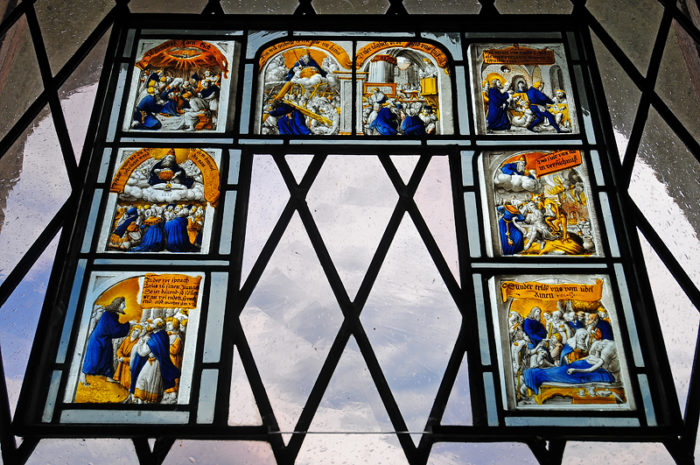
Zur Kirche Einigen
Die Kirche Einigen ist die älteste romanische Kirche der sog. „1000jährigen Kirchen am Thunersee“, geplant von Arnold von Strättligen, erbaut durch König Rudolf II. von Burgund, geweiht dem Erzengel Michael.
Bei der Restauration 1954 bis 1956 wurden Grundmauern von einer noch älteren, kleineren Kirche gefunden: ein quadratischer Raum mit halbrundem Chorabschluss und seitlich eingebauter Grabkammer; dazu 15 Gräber mit Skeletten, eines aus dem 5. Jahrhundert. Sagen von einer heilsamen Quelle und Legenden um den heiligen Beatus verweisen schon früh auf einen Wallfahrtsort, dessen älteste Mauerreste aus keltischer Zeit stammen sollen.

1228 wird diese Kirche zum ersten Mal urkundlich erwähnt und 1460 in der „Strättliger Chronik“ ausführlich beschrieben als „Kirchlein St. Michael im Paradies am Wendelsee“. An der gotischen Holzdecke ist über der Orgel gut sichtbar eine Teufelsfratze zur Erinnerung an eine Beatus-Legende.
Beachtenswert: der Taufstein 1446 mit Stifterwappen von Bubenberg, die „Unser-Vater-Scheibe“ (1563?) im mittleren Chorfenster, die drei Wappenscheiben der Adelsfamilie von Erlach, die barocke Kanzel, das Lesepult, der handgefertigte Kelch beim Abendmahl und die Orgel (Kuhn/Männedorf 1948).
Seit der Reformation 1528 gehört diese Kirche zur Evangelisch-Reformierten Landeskirche des Kantons Bern – ein stiller Ort zur persönlichen Besinnung und Begegnung mit Gott.
L’Eglise Einigen est la plus ancienne des églises romanes millénaires entourant le lac de Thoune. Les plans furent l’oeuvre d’Arnold de Strättligen. Elle fut bâtie par Rodolphe II, roi de Bourgogne et consacrée à l’archange Saint Michel. Lors de sa restauration 1954/56 on découvrit les fondations d’une église plus petite et plus ancienne encore: une salle carrée avec un choeur semi-circulaire sur le côté une sépulture, 15 tombeaux avec squelettes dont un du 5ième siècle. Des légendes très anciennes d’une source miraculeuse et de St.-Béat se réfèrent déjà à un lieu de pèlerinage où les plus vieux murs restants dateraient de l’époque celte.
En 1228, pour la première fois, cette église est mentionnée sur un document authentique et en 1460, dans la „Chronique de Strättligen“. Elle est décrite en détail comme étant une „Petite église de St.-Michel en Paradis sur les rives du Wendelsee“. Sur le plafond en bois de style gothique au-dessus de l’orgue un masque du diable est bien visible, en souvenir d’une légende de St.-Béat. A observer: le baptistère 1446 avec les armoiries du donateur von Bubenberg, les vitraux du „Notre Père“ (1563?) à la fenêtre centrale du choeur, les trois vitraux avec les armoiries des von Erlach, la chaire baroque, le lutrin 1676, la coupe pour la Sainte-Cène faite à la main et l’orgue (Kuhn/Männedorf 1948).
Depuis la Réforme 1528 cette église appartien à l’Eglise réformée évangelique du canton de Berne – un espace de silence, de méditation, de recueillement et de rencontre avec Dieu.
Questa è la più antica chiesa romanica delle „chiese millenarie sul lago di Thun“. Progettata da Arnold von Strättligen, fu fatta costruire dal re Rodolfo di Borgogna e dedicata all’Arcangelo Michele. All’interno, durante il restauro nel 1954/56, sono state ritrovate le fondamenta di una chiesa, ancora più piccola e più antica, una saletta quadrata con abside semicircolare e con una stanza funebre aggiunta lateralmente; la più antica delle 15 tombe datava del V secolo. Ci sono leggende di una sorgente salutare e di San Beato che indicano l’esistenza di un vecchio luogo di pellegrinaggio. Si dice che le mura più antiche della chiesa appartengano a detto luogo e che risalgano ai tempi celtici.
Nel 1228 la chiesa viene nominata per la prima volta in una bolla. La „Strättliger Chronik“ (cronaca di Strättligen) nel 1460, la descrive dettagliatamente come „Chiesetta di San Michele in Paradiso sul lago di Wendel“. Al soffitto gotico, sopra l’organo ben in vista, c’è la grinta di un diavolo a ricordare una leggenda del San Beato. Degni di nota sono: il fonte battesimale con gli stemmi del donatore von Bubenberg 1446; la finestra mediana del coro (1563?) rappresentante „il Padre Nostro“; in più i tre vetri con gli stemmi di von Erlach; il pulpito barocco, il leggio 1676; il calice della Santa Cena fatto a mano e infine l’organo (Kuhn/Männedorf 1948).
Dalla Riforma 1528 questa chiesa appartiene alla Chiesa evangelica-riformata del Cantone di Berna. Le quattro campane del campanile invitano regolarmente a visitare questo luogo tranquillo, di riflessione e di comunicazione con Dio.

This church is the oldest romanesque church of the so-called 1000 year old churches that are situated around the Lake of Thun. It was planned by Arnold von Strättligen, built during the reign of King Rudolf II of Burgundy and dedicated to the archangel Michael.
During the restauration in 1954/56 foundation walls of an even older, smaller church were found. A square room with a semi-arched choir including a tomb chamber which was built in on one side, what more, 15 graves with skeletons, one dating back to the 5th century A.D.
Legends of a healing source and legends concerning holy Beatus indicate the early presence of a place of pilgrimage where the oldest rests of walls should date back as far as to the celtic aera.
This church was first testimonally mentioned in 1228 and was described in detail in the chronicle of strättligen in 1460 as the „Little Church St. Michael in Paradise on the Lake of Wendel“. A devil’s grimace, which reminds of a Beatus legend, is well recognized on the gothic wooden ceiling. To be noticed are: the font 1446 with the coat of arms of the canon von Bubenberg, the „Lord’s Prayer pane“ (1563?), in the middle choir window, the three coat of arms panes von Erlach, the baroque pulpit, the reading desk 1676, the manually skilled chalice used at the participation in sacrament of the Lord’s Supper and the organ (Kuhn/Männedorf 1948).
This church belongs to the Evangelical Reformed State Church of the Kanton of Berne since the Reformation 1528. It is a quiet place where the four bells in the belfry regularly invite to personal contemplation and to meet God.